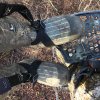BLUF: If you are going to sew, make sure you know how to sew properly for the application.
So it sounds like some people are having problems with buckles and/or stitching failures. People need to be careful with sewing especially if you are new with it. I am still waiting on all my stuff to come in that I ordered to make mine with all rated weight bearing components. From my research on sewing I learned that the forces applied to the stitching when sewing a foot loop are different than on a loop attached to a small hook or carabineer sized attachment. Essentially the wider eye on the foot loop pulls the straps apart pulling on the stitches, so the forces applied include, not only a downward force vector, but also a pulling the straps apart force vector. (Very technical terms there, LOL) With the smaller eye there isn't a pulling the strap apart force vector. Not sure if that makes any sense or not. If not, let me know and I can try to draw a simple diagram to illustrate. The bottom line is make sure you are sewing properly, and if you aren't sure you are, then consider just using knots or a configuration using pre-sewn/manufactured rated components.





